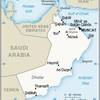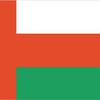Oman [+]Compare [E]dit [H]istory
Aliases: Saltanat Uman, Sultanate of Muscat and Oman, Sultanate of Oman, UmanObject «Oman» was created due to
Add new object to «Oman» or move existing objects here.
Object «Oman» has attributes [Show empty attributes][Hide empty attributes]
| Attribute | Value |
|---|---|
| Geography | |
| Area | 309,500 km² |
| Continent | Asia |
| Land area | 309,500 km² |
| Water area | 0 km² |
| Land boundaries | 1,561 km |
| Border countries |
|
| Coastline | 2,092 km |
| Mean elevation | 310 m |
| Lowest point | 0 m |
| Highest point | 3,004 m |
| People | |
| Population | 4,664,844 |
| Official languages |
|
| Religion | Muslim |
| Government | |
| Long country name | Sultanate of Oman |
| Short country name | Oman |
| Long local name | Saltanat Uman |
| Short local name | Uman |
| Former name |
|
| Government type | Absolute monarchy |
| Capital | Muscat |
| Economy | |
| GDP (PPP) | 190,100,000,000 USD |
| GDP (OER) | 70,780,000,000 USD |
| GDP (real growth rate) | -0.9 % |
| GDP - per capita (PPP) | 46,000 USD |
| Gross national saving | 16.1 % of GDP |
| Labor force | 2,255,000 |
| Unemployment rate | Add |
| Population below poverty line | Add |
| Budget revenues | 22,140,000,000 USD |
| Budget expenditures | 31,920,000,000 USD |
| Military expenditures | 8.17 % of GDP |
| Taxes and other revenues | 31.3 % of GDP |
| Budget surplus or deficit | -13.8 % of GDP |
| Public debt | 46.9 % of GDP |
| Inflation rate | 1.6 % |
| Central bank discount rate | 2 % |
| Commercial bank prime lending rate | 5.2 % |
| Stock of narrow money | 12,850,000,000 USD |
| Stock of broad money | 12,850,000,000 USD |
| Stock of domestic credit | 48,470,000,000 USD |
| Market value of publicly traded shares | 41,120,000,000 USD |
| Current account balance | -10,760,000,000 USD |
| Exports | 103,300,000,000 USD |
| Imports | 24,120,000,000 USD |
| Reserves of foreign exchange and gold | 16,090,000,000 USD |
| External debt | 46,270,000,000 USD |
| National currency | Omani rials |
| National currency (code) | OMR |
| National currency (symbol) | ﷼ |
| National currency rate to USD | 0.3845 |
The inhabitants of the area of Oman have long prospered from Indian Ocean trade. In the late 18th century, the nascent sultanate in Muscat signed the first in a series of friendship treaties with Britain. Over time, Oman's dependence on British political and military advisors increased, although the sultanate never became a British colony. In 1970, QABOOS bin Said Al-Said overthrew his father, and has since ruled as sultan. Sultan QABOOS has no children and has not designated a successor publicly; the Basic Law of 1996 outlines Oman’s succession procedure. Sultan QABOOS’ extensive modernization program opened the country to the outside world, and the sultan has prioritized strategic ties with the UK and US. Oman's moderate, independent foreign policy has sought to maintain good relations with its neighbors and to avoid external entanglements.
Inspired by the popular uprisings that swept the Middle East and North Africa beginning in January 2011, some Omanis staged demonstrations, calling for more jobs and economic benefits and an end to corruption. In response to those protester demands, QABOOS in 2011 pledged to implement economic and political reforms, such as granting Oman’s bicameral legislative body more power and authorizing direct elections for its lower house, which took place in November 2011. Additionally, the Sultan increased unemployment benefits, and, in August 2012, issued a royal directive mandating the speedy implementation of a national job creation plan for thousands of public and private sector Omani jobs. As part of the government's efforts to decentralize authority and allow greater citizen participation in local governance, Oman successfully conducted its first municipal council elections in December 2012. Announced by the sultan in 2011, the municipal councils have the power to advise the Royal Court on the needs of local districts across Oman's 11 governorates.
Similar objects
Most often compared with
Everyone can something to edit or add.
There were 2 edits, no edits waiting approval. Last edited by Guest_1196(-101), May 26, 2020 (49 fields were changed)
Help · Contact us · Disclaimer · Contributors · Developers · Donate


